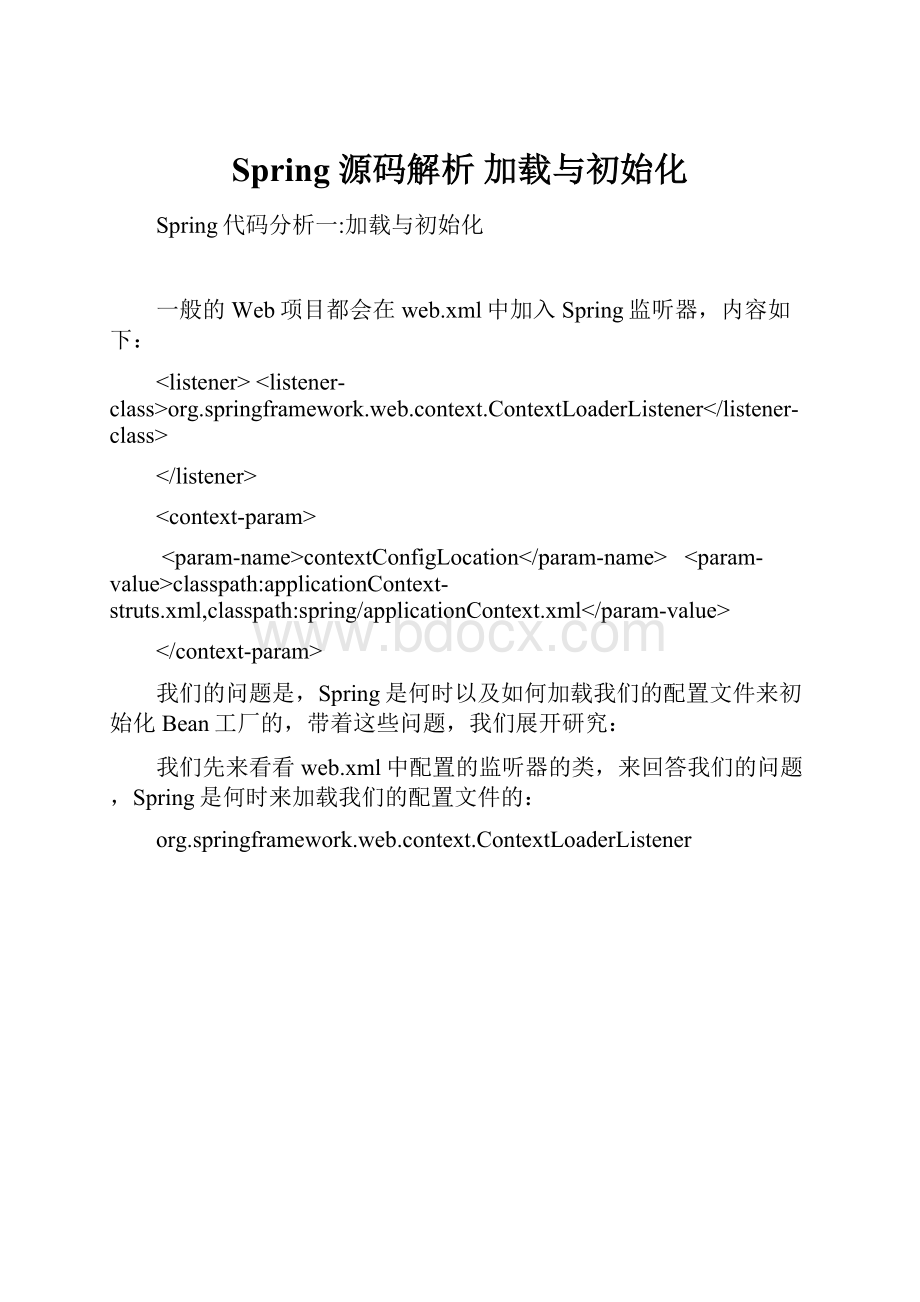Spring 源码解析 加载与初始化.docx
《Spring 源码解析 加载与初始化.docx》由会员分享,可在线阅读,更多相关《Spring 源码解析 加载与初始化.docx(20页珍藏版)》请在冰豆网上搜索。

Spring源码解析加载与初始化
Spring代码分析一:
加载与初始化
一般的Web项目都会在web.xml中加入Spring监听器,内容如下:
org.springframework.web.context.ContextLoaderListener
contextConfigLocationclasspath:
applicationContext-struts.xml,classpath:
spring/applicationContext.xml
我们的问题是,Spring是何时以及如何加载我们的配置文件来初始化Bean工厂的,带着这些问题,我们展开研究:
我们先来看看web.xml中配置的监听器的类,来回答我们的问题,Spring是何时来加载我们的配置文件的:
org.springframework.web.context.ContextLoaderListener
它继承了javax.servlet.ServletContextListener接口。
ServletContextListener是J2EEServletAPI中的一个标准接口,
它能够监听ServletContext对象的生命周期,实际上就是监听Web应用的生命周期。
当Servlet容器启动或终止Web应用时,会触发ServletContextEvent事件,该事件由ServletContextListener来处理。
这里面有两个方法我们比较感兴趣:
/**
*CreatetheContextLoadertouse.Canbeoverriddeninsubclasses.
*@returnthenewContextLoader
*/
ProtectedContextLoadercreateContextLoader(){
ReturnnewContextLoader();
}
这个方法构造一个默认的ContextLoader,ContextLoader可以理解为Spring上下文的加载器。
之所以这样去定义这样一个类,是为了开发人员进行重写此方法来使用一个自定义的Spring上下文的加载器。
/**
*Initializetherootwebapplicationcontext.
*/
PublicvoidcontextInitialized(ServletContextEventevent){
this.contextLoader=createContextLoader();
this.contextLoader.initWebApplicationContext(event.getServletContext());
}
这个方法很简单,仅仅只是调用了createContextLoader()构造了ContextLoader,并调用其初始化方法。
由此,我们可以得出结论,Spring是在Web项目启动时,通过ServletContextListener机制,来加载以及初始化Spring上下文的。
下面,我们好好研究一下Spring是如何加载其上下文的:
我们先定位ContextLoader类。
看看此类的initWebApplicationContext()方法(省略了不重要的语句)
/**
*InitializeSpring'swebapplicationcontextforthegivenservletcontext,
*accordingtothe"{@link#CONTEXT_CLASS_PARAMcontextClass}"and
*"{@link#CONFIG_LOCATION_PARAMcontextConfigLocation}"context-params.
*@paramservletContextcurrentservletcontext
*@returnthenewWebApplicationContext
*@throwsIllegalStateExceptionifthereisalreadyarootapplicationcontextpresent
*@throwsBeansExceptionifthecontextfailedtoinitialize
*@see#CONTEXT_CLASS_PARAM
*@see#CONFIG_LOCATION_PARAM
*/
publicWebApplicationContextinitWebApplicationContext(ServletContextservletContext)
throwsIllegalStateException,BeansException{
if(servletContext.getAttribute(WebApplicationContext.ROOT_WEB_APPLICATION_CONTEXT_ATTRIBUTE)!
=null){
thrownewIllegalStateException(
"Cannotinitializecontextbecausethereisalreadyarootapplicationcontextpresent-"+
"checkwhetheryouhavemultipleContextLoader*definitionsinyourweb.xml!
");
}
try{
//Determineparentforrootwebapplicationcontext,ifany.
ApplicationContextparent=loadParentContext(servletContext);
//Storecontextinlocalinstancevariable,toguaranteethat
//itisavailableonServletContextshutdown.
this.context=createWebApplicationContext(servletContext,parent);
servletContext.setAttribute(WebApplicationContext.ROOT_WEB_APPLICATION_CONTEXT_ATTRIBUTE,this.context);
currentContextPerThread.put(Thread.currentThread().getContextClassLoader(),this.context);
returnthis.context;
}catch(RuntimeExceptionex){
logger.error("Contextinitializationfailed",ex);
servletContext.setAttribute(WebApplicationContext.ROOT_WEB_APPLICATION_CONTEXT_ATTRIBUTE,ex);
throwex;
}catch(Errorerr){
logger.error("Contextinitializationfailed",err);
servletContext.setAttribute(WebApplicationContext.ROOT_WEB_APPLICATION_CONTEXT_ATTRIBUTE,err);
throwerr;
}
}
其中的有两句比较重要,我们来看看:
ApplicationContextparent=loadParentContext(servletContext);
这个方法的用途主要是用来解决Spring共享环境的,即,如果我们有多个WAR包部署在同一个服务器上,而且这些WAR都共享某一套业务逻辑层。
如何共享一套业务逻辑包配置而不要每个WAR都单独配置,这时我们就可能需要Spring的共享环境了。
ProtectedApplicationContextloadParentContext(ServletContextservletContext)throwsBeansException{
ApplicationContextparentContext=null;
//从web.xml中读取父工厂的配置文件,默认为:
"classpath*:
beanRefContext.xml"
StringlocatorFactorySelector=servletContext.getInitParameter(LOCATOR_FACTORY_SELECTOR_PARAM);
//从web.xml中读取父类工厂的名称
StringparentContextKey=servletContext.getInitParameter(LOCATOR_FACTORY_KEY_PARAM);
if(parentContextKey!
=null){
//locatorFactorySelectormaybenull,indicatingthedefault"classpath*:
beanRefContext.xml"
BeanFactoryLocatorlocator=ContextSingletonBeanFactoryLocator.getInstance(locatorFactorySelector);
this.parentContextRef=locator.useBeanFactory(parentContextKey);
parentContext=(ApplicationContext)this.parentContextRef.getFactory();
}
returnparentContext;
}
现在我们引入BeanFactoryLocator,它是Spring配置文件的一个定位器,Spring官方给它的定义是用来查找,使用和释放一个BeanFactory或其子类的接口。
下面我们看看此图:
ContextSingletonBeanFactoryLocator.getInstance(locatorFactorySelector);
是根据参数locatorFactorySelector去一个单例工厂中去拿一个对应的BeanFactoryLocator,也即,如果工厂中没有对应于locatorFactorySelector的BeanFactoryLocator对象,那就返回一个新的BeanFactoryLocator实例(这里是ContextSingletonBeanFactoryLocator的实例),否则,就从工厂里取现有的BeanFactoryLocator对象。
ContextSingletonBeanFactoryLocator里维护了一个静态的Map对象instances,每次需要新增BeanFactoryLocator实例时都会更新这个Map对象,这个Map对象是以配置文件名为KEY,BeanFactoryLocator对象为值。
原因很简单,就是希望同一个配置文件只被初始化一次。
如果没有在web.xml中定义locatorFactorySelector这个参数,父环境的配置文件默认使用:
"classpath*:
beanRefContext.xml"
this.parentContextRef=locator.useBeanFactory(parentContextKey);
此方法定义在SingletonBeanFactoryLocator类中,同样是一个单例工厂模式,判断传入的参数parentContextKey对应的BeanFactory是否有被初始化,经过上面的ContextSingletonBeanFactoryLocator.getInstance(locatorFactorySelector)指定Spring父环境配置文件,这个方法判断指定的父环境是否被初始化,如果有则返回,没有就进行初始化。
看看此方法的实现:
PublicBeanFactoryReferenceuseBeanFactory(StringfactoryKey)throwsBeansException{
synchronized(this.bfgInstancesByKey){
BeanFactoryGroupbfg=(BeanFactoryGroup)this.bfgInstancesByKey.get(this.resourceLocation);
if(bfg!
=null){
bfg.refCount++;
}else{
//CreatetheBeanFactorybutdon'tinitializeit.
BeanFactorygroupContext=createDefinition(this.resourceLocation,factoryKey);
//Recorditsexistencenow,beforeinstantiatinganysingletons.
bfg=newBeanFactoryGroup();
bfg.definition=groupContext;
bfg.refCount=1;
this.bfgInstancesByKey.put(this.resourceLocation,bfg);
this.bfgInstancesByObj.put(groupContext,bfg);
//NowinitializetheBeanFactory.Thismaycauseare-entrantinvocation
//ofthismethod,butsincewe'vealreadyaddedtheBeanFactorytoour
//mappings,thenexttimeitwillbefoundandsimplyhaveits
//referencecountincremented.
try{
initializeDefinition(groupContext);
}catch(BeansExceptionex){
this.bfgInstancesByKey.remove(this.resourceLocation);
this.bfgInstancesByObj.remove(groupContext);
thrownewBootstrapException("Unabletoinitializegroupdefinition."+
"Groupresourcename["+this.resourceLocation+"],factorykey["+factoryKey+"]",ex);
}
}
try{
BeanFactorybeanFactory=null;
if(factoryKey!
=null){
beanFactory=(BeanFactory)bfg.definition.getBean(factoryKey,BeanFactory.class);
}elseif(bfg.definitioninstanceofListableBeanFactory){
beanFactory=(BeanFactory)BeanFactoryUtils.beanOfType((ListableBeanFactory)bfg.definition,BeanFactory.class);
}else{
thrownewIllegalStateException(
"Factorykeyisnull,andunderlyingfactoryisnotaListableBeanFactory:
"+bfg.definition);
}
returnnewCountingBeanFactoryReference(beanFactory,bfg.definition);
}catch(BeansExceptionex){
thrownewBootstrapException("UnabletoreturnspecifiedBeanFactoryinstance:
factorykey["+
factoryKey+"],fromgroupwithresourcename["+this.resourceLocation+"]",ex);
}
}
}
此方法分为两作了两件事,
第一,初始化上下文,注意这里初始化的是从web.xml配置参数里的Spring配置文件,也是上面讲loadParentContext方法里的
BeanFactoryLocatorlocator=ContextSingletonBeanFactoryLocator.getInstance(locatorFactorySelector);
这句指定的参数。
这里初始化的是这个配置文件所有Bean。
我们指定的factoryKey对应的Bean也是其中之一。
第二,从已经初始化的Spring上下文环境中获取Spring父环境。
sharebean.xml
sharebean2.xml
—=========================web.xml=========================-->
locatorFactorySelector
beanRefFactory.xml
parentContextKey
factoryBeanId
这个一个典型的构造父环境的配置,web项目在启动的时候就会发现里面有Spring父环境的配置,那么Spring首先就会生成一个对应的配置文件为beanRefFactory.xml的BeanFactory(web.xml中的locatorFactorySelector参数指定),同时Spring在解析的时候,会发现factoryBeanId的配置同样为BeanFacotry(beanRefFactory.xml中factoryBeanId对应的Bean),所以Spring在拿父环境时就会写成:
beanFactory=(BeanFactory)bfg.definition.getBean(factoryKey,BeanFactory.class);
方法实现里引入了BeanFactoryGroup类。
类的结构很简单
refCount:
用来记录实例被外部引用的记数,当调用locator.useBeanFactory(parentContextKey)方法时,引用数就会加1,当调用CountingBeanFactoryReference#release方法时,引用数就会减1,当它变成0时,Spring就会释放掉它占用的内存,同时也会销毁掉它definition变量引用的BeanFactory。
下次再调用locator.useBeanFactory(parentContextKey)就会重新初始化BeanFactory。
说到release,请同学们参考ContextLoader中如下的两条语句:
//在调用CountingBeanFactoryReference#release后,即使对象已经销毁,这个Map仍然可以返回locator对象。
BeanFactoryLocatorlocator=ContextSingletonBeanFactoryLocator.getInstance(locatorFactorySelector);
//如果对象已经销毁,再调用此方法会再一次初始化BeanFactory
this.parentContextRef=locator.useBeanFactory(parentContextKey);
bfgInstancesByKey:
一个Map对象,以配置文件名为Key,配置文件解析后生成的BeanFactory构成的BeanFactoryGroup为值。
bfgInstancesByObj:
一个Map对象,以BeanFactoryGroup.definitiion为Key,以BeanFactoryGroup为值。
这个对象主要还是在CountingBeanFactoryReference#release时使用。
下面,我看再看看另一个地方:
if(parentContextKey!
=null){
//locatorFactorySelectormaybenull,indicatingthedefault"classpath*:
beanRefContext.xml"
BeanFactoryLocatorlocator=ContextSingletonBeanFactoryLocator.getInstance(locatorFactorySelector);
this.parentConte